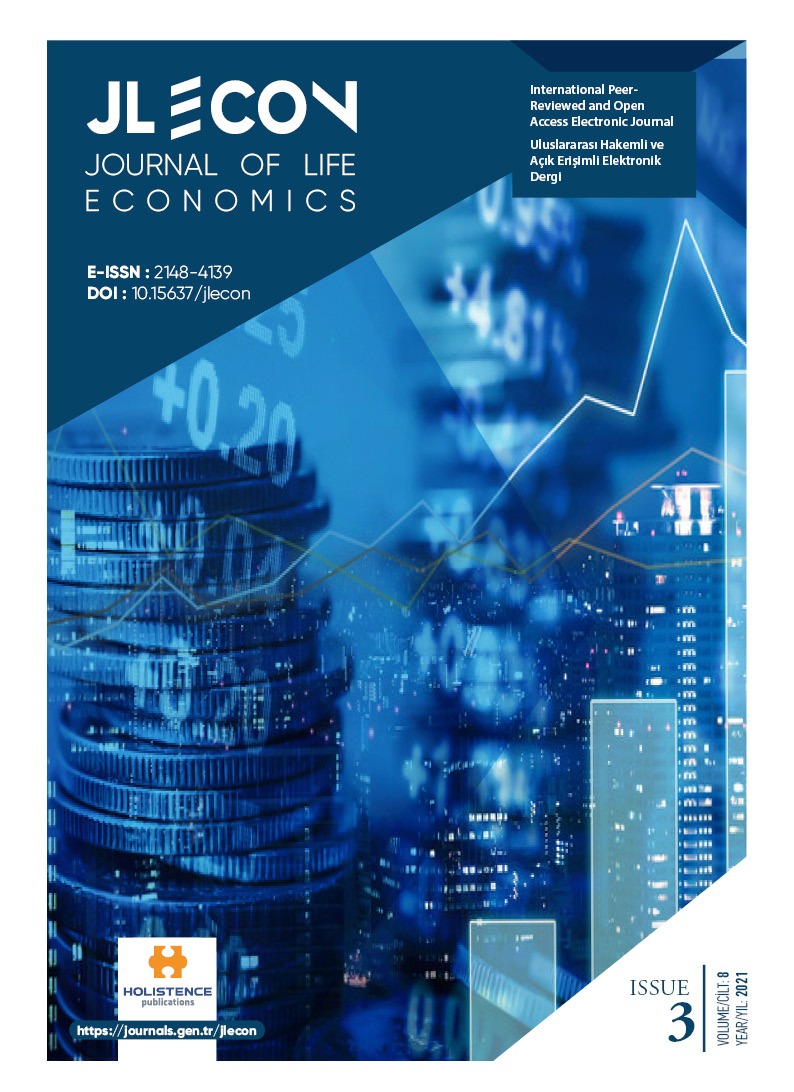Comparative efficiency and capacity analysis of Waqf Agricultural Enterprises (19th century Ottoman and the 21st century Turkey: Aegean Example)
DOI:
https://doi.org/10.15637/jlecon.8.3.02Keywords:
waqf, agricultural enterprises, iltizam, productivityAbstract
In the study, the foundation olive groves as the foundation agricultural enterprises in the 19th century Ottoman Empire Aegean Region and the 21st century Ayvalik Waqf Olive Groves Management Directorate are examined in terms of productivity and capacity. When the Aegean Region waqf agricultural enterprises were examined in the 19th century, generally waqf olive groves were found. In addition, today's Ayvalık agricultural waqf enterprise is examined. When doing research, Ottoman Archive documents and Ayvalık Waqf Olive Groves reports are used. In the waqf olive groves; When we make a comparison on the basis of villages, today's productivity has increased three times at most in some villages, sometimes the same, sometimes less, compared to the 19th century. Although today's socio-economic conditions and technology are in a better state, there has not been a serious difference in productivity. In the Ottoman Empire, foundation agricultural enterprises were operated by the method of tax-farming. Since today’s waqf agricultural enterprises are operated in a similar way to the tax farming method, we can say that olive groves are operated by modern tax-farming method.
Downloads
References
ALKIN, E. (1988). İktisadi Giriş. 4. Baskı, İstanbul: Kanaat Printing Press
ARMAĞAN, A. (2017). Kemer-Edremit Voyvodası el-Hâc Ali Ağa bin el-Hâc Ahmet Ağa’nın Kemer-Edremit’te Kurduğu Vakıf ve Vakfiyesi. OTAM, 42, 1-46.
Ayvalık Vakıflar Agricultural Enterprise Management Reports
DİNLER, Z. (2014). Tarım Ekonomisi, Bursa: Ekin Publishing House
DOĞAN, F. (2007). Osmanlı Devleti’nde Zeytinyağı (1800-1920). Phd. Thesis, Marmara Üniversitesi Sosyal Bilimler Enstitüsü İktisat Tarihi Abd. (2007)
GÜRAN, T. (2013). 19.Yüzyılda Osmanlı Ekonomisi Üzerine Araştırmalar. İstanbul: İş Bankası Kültür Publications
GÜRAN,T. (1998), 19.Yüzyıl Osmanlı Tarımı, İstanbul: Eren Publishing House
http://www.olive.info.tr/?p=147 (Date of access: 02.12.2020) http://koop.gtb.gov.tr/data/5ad06f17ddee7dd8b423eb2e/2017%20Zeytinya%C4%9F%C4%B1%20Raporu.pdf, (Date of access: 17.04.2020)
https://www.sayistay.gov.tr (Date of access: 03.03.2019)
https://www.vakifzeytinleri.gov.tr/hakkimizda (Date of access: 04.04.2019)
ISLAMOGU, H., ed. (2004). The Ottoman Empire and the World-Eeconomy. Vol. 12. Cambridge University Press, 2004
ÖZGÜVEN, A. (1983). Tarım Ekonomisi ve Politikası. İstanbul: Filiz Publishing House.
ÖZTÜRK, N. (1995), Türk Yenileşme Tarihi Çerçevesinde Vakıf Müessesesi. Türkiye Diyanet Vakfı Publication, İstanbul
PASKALEVA, V. (1967). Osmanlı Balkan Eyaletlerinin Avrupalı Devletlerle Ticaretleri Tarihine Katkı 1700–1850. İÜ. İktisat Fakültesi Dergisi, 27 (1–2): 48–59.
REDHOUSE, S.J. (2011). Turkish and English Lexicon. İstanbul:Çağrı Publication
State Archives Ottoman Archive (BOA). Evd 24925, 1297—Za.22—1297.Za.26---27.10.1880—31.10.1880
State Archives Ottoman Archive (BOA). Evd 24930, 1297—Za.29---03.11.1880
State Archives Ottoman Archive (BOA). HH, Number: 32371, 1246 / 1830-31.
YEDIYILDIZ, B. (1984). XVIII Asırda Vakıfların İktisadi Boyutu. Vakıflar Dergisi, XVIII, 5-41.
Downloads
Published
How to Cite
Issue
Section
License
Copyright (c) 2021 Holistence Publications

This work is licensed under a Creative Commons Attribution 4.0 International License.
When the article is accepted for publication in the Journal of Life Economics, authors transfer all copyright in the article to the Holistence Publications.The authors reserve all proprietary right other than copyright, such as patent rights.
Everyone who is listed as an author in this article should have made a substantial, direct, intellectual contribution to the work and should take public responsibility for it.
This paper contains works that have not previously published or not under consideration for publication in other journals.

















